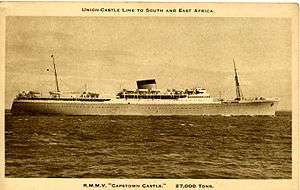RMMV Capetown Castle
 Postcard of RMMV Capetown Castle | |
| History | |
|---|---|
| Name: | RMMV Capetown Castle |
| Owner: | Union-Castle Mail Steam Ship Company |
| Port of registry: |
London, |
| Route: | Southampton-Las Palmas-Cape Town-Port Elizabeth-East London-Durban |
| Builder: | Harland & Wolff, Belfast[1] |
| Yard number: | 986[2] |
| Launched: | 23 September 1937[1] |
| Completed: | 31 March 1938[2] |
| Maiden voyage: | 29 April 1938 |
| Out of service: | 9 September 1967 |
| Fate: | Scrapped, 1967[3] |
| General characteristics | |
| Type: | Passenger liner |
| Tonnage: | 27,002 GRT[1] |
| Length: | 734 ft (224 m)[3] |
| Beam: | 82 ft 6 in (25.15 m)[3] |
| Draught: | 32 ft (9.8 m)[1] |
| Installed power: | 28,000bhp |
| Propulsion: |
|
| Speed: | 20 knots (37 km/h; 23 mph)[3] |
| Capacity: |
|
RMMV Capetown Castle was a British passenger liner built by Harland & Wolff at Belfast for the Union-Castle Line's mail service from Southampton to South Africa.
The ship was launched on 23 September 1937 and was a slightly enlarged version of the Stirling Castle and Athlone Castle of 1936. After the outbreak of World War II, in January 1940, the government introduced the Liner Requisition Scheme and Capetown Castle was taken up for conversion into a troop ship. In 1943 she took part in Operation Bolero, the build-up of troops in preparation for D-Day, and was eventually returned to her owners in 1946, having sailed 484,000 miles and carried over 164,000 troops. The ship was refurbished at Belfast and returned to commercial service on 9 January 1947.[3]
On 17 October 1960 the ship was arriving at Las Palmas when an explosion occurred in the engine room killing seven crewmen.[4] In July 1965 a long planned acceleration of the Cape mail service was introduced, reducing the passage time by two days. The new schedule required only seven ships rather than eight and Capetown Castle, like her near sisters Athlone Castle and Stirling Castle did not have enough speed to maintain it.[5] The three were replaced by two fast cargo liners (Southampton Castle and Good Hope Castle) and the earlier two ships were sold for breaking up. The Good Hope Castle was late being delivered and Capetown Castle was kept on in the mail service until the new ship arrived in January 1966. She was then put on an "extra" service from Southampton to Cape Town via Flushing(Vlissingen), Madeira, Ascension, St. Helena and Walvis Bay. This continued for almost two years until she made her final arrival at Southampton on September 9th 1967 where she was withdrawn from service. She was sold for scrap and left Southampton on September 19th for La Spezia, arriving on September 26th for breaking up by Terrestre Marittima.[6]
References
- 1 2 3 4 Gascoyne, Rodney (2011). "Ships and Trips of Union-Castle Line". members.shaw.ca. Retrieved 17 October 2012.
- 1 2 McCluskie, Tom (2013). The Rise and Fall of Harland and Wolff. Stroud: The History Press. p. 145. ISBN 9780752488615.
- 1 2 3 4 5 "Union-Castle Mail Steamship Co.". red-duster.co.uk. 2010. Retrieved 17 October 2012.
- 1 2 "Air Start Explosion of the Capetown Castle". marinediesels.info. 2012. Retrieved 17 October 2012.
- ↑ Mitchell & Sawyer, The Cape Run
- ↑ Kludas, Great Passenger Ships of the World Vol.4
External links
- Gascoyne, Rodney. "Life at Sea with Union-Castle". An account of life on board this ship and others of the Union-Castle Line in the 1960s.
- Boyle, Ian. "Capetown Castle - Union-Castle Line". Postcards and photographs of Capetown Castle.